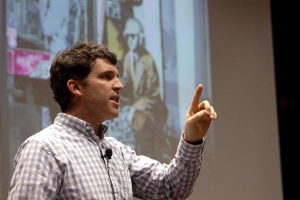
 “Would Banksy have been as well known and liked twenty years ago before social media?” asked Dr. James Swenson (Department of Comparative Arts and Letters). Because Swenson was lecturing on Banksy Does New York (2014), a documentary about the well-known street artist’s installations, he felt that the lecture should be interactive, just like Banksy’s work. To begin, he shared a photo of his fourteen year old nephew, who upon hearing that his uncle would be lecturing on Banksy responded, “Banksy? I know him.” Swenson, shocked, asked how he didn’t know anything about art but still knew Banksy, and the boy responded, “I follow him on Instagram.”
“Would Banksy have been as well known and liked twenty years ago before social media?” asked Dr. James Swenson (Department of Comparative Arts and Letters). Because Swenson was lecturing on Banksy Does New York (2014), a documentary about the well-known street artist’s installations, he felt that the lecture should be interactive, just like Banksy’s work. To begin, he shared a photo of his fourteen year old nephew, who upon hearing that his uncle would be lecturing on Banksy responded, “Banksy? I know him.” Swenson, shocked, asked how he didn’t know anything about art but still knew Banksy, and the boy responded, “I follow him on Instagram.”
Banksy’s art, according to Swenson, does not emerge from a vacuum. He is the progeny of other artists who similarly stretched the definitions and conceptualizations of art. Swenson pointed to Duchamp’s Fountain as one seminal work that challenged the idea of art; as Duchamp described it, the work is completely anti-retinal meaning that the art is not produced for its aesthetic qualities but purely as a concept. Similarly, László Maholy-Nagy’s Light-Space Modulator is a work of mechanical Bauhausian sculpture, but the artwork is not the sculpture, rather the gallery itself becomes the work when the light and sounds projected onto the walls when the mechanism is turned on.
Banksy’s work is not about the pieces themselves, which are highly replicable and destructible. Often they are more about his power to orchestrate his audience’s reaction in real life and online. When asked who had sought out and visited Banksy pieces in the real world, a number of students raised their hands. Locally, there is one just off of Main Street in Park City and many people go find it like a real-world scavenger hunt to take photos or selfies with it. As the documentary depicts, Banksy’s genius is not in the stencils or sculptures themselves, but in the socialization that surrounds them.
When Swensen asked the audience to explain why they liked Banksy, some answered that it was in part the mystery surrounding Banksy’s anonymity, for others, the graphic quality of the works, for others it was that the art was subversive, sneaky, and even illegal. The fact that most of Banksy’s works are site-specific means that you have to go see them in the world and not in a museum (until they are sold at auction). His stencils are funny and have a social critique; many of Banksy’s most famous works are humorous interactions with the real world but positioned so that his stencils re-contextualizes the world’s objects. Additionally, these interactions, while funny, are often used to offer critiques of political movements, social injustices, and spatial unawareness. The largest number of students explained that the appeal of Bansky was that he thumbs his nose at the contemporary art world. He gives his work away for free although the owners of the buildings tagged by his art might decide to sell it or destroy it. Banksy eschews the order and haughtiness of contemporary art by making things simple to understand and pulling tricks on art collectors such as his infamous self-shredding frame that destroyed one of his prints the moment it was sold at auction.
